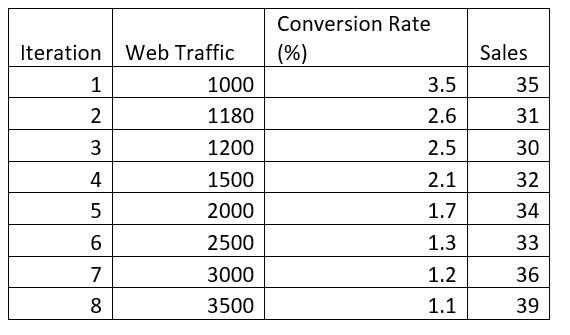PMI-ACP Practice Questions #114
As a Product Owner of an e-commerce platform, your sales team has shared the following insights from the past 8 iterations:

You now need to investigate further to understand the cause of these trends and decide what actions to take.
As a Product Owner, what would you like to investigate further?
A. Checkout Process & Traffic Quality – Identify friction points in checkout and assess visitor relevance.
B. Mobile Optimization & Product Pricing – Analyze mobile usability issues and impact of pricing on conversions.
C. Page Load Speed & Marketing Targeting – Measure page performance and evaluate campaign effectiveness.
D. User Behavior & Promotion Impact – Study drop-off points and effectiveness of current discounts.
Analysis
The provided data shows three key trends:
- Web traffic has significantly increased from 1000 to 3500 over the last eight iterations.
- Conversion rate has steadily declined from 3.5% to 1.1%.
- Sales numbers have remained relatively stable, showing only a slight increase despite the surge in traffic.
This suggests a disconnect between increased traffic and actual conversions. More visitors are coming to the site, but fewer of them are making purchases, which means there could be issues with traffic quality, checkout friction, or visitor engagement. The goal of further investigation should be to identify why the increased traffic is not leading to higher conversions.
Analysis of Options
A: Checkout Process & Traffic Quality – Identify friction points in checkout and assess visitor relevance.
This is the best option because it directly investigates both key problem areas:
- Friction in the checkout process: A declining conversion rate suggests that visitors may be experiencing usability issues, unnecessary steps, or unclear payment processes.
- Visitor relevance: Since traffic has increased significantly but sales have not, the new visitors may not be the right target audience. If marketing campaigns are attracting low-quality traffic, conversion rates will drop.
Analyzing checkout process efficiency and traffic relevance will provide critical insights into why conversions are declining.
B: Mobile Optimization & Product Pricing – Analyze mobile usability issues and impact of pricing on conversions.
This option assumes that mobile usability or pricing changes might be causing lower conversions. However, the data does not indicate any known mobile-specific issues or pricing fluctuations. While pricing could impact conversion rates, there is no evidence in the dataset that pricing has changed, making this investigation less relevant to the given problem.
C: Page Load Speed & Marketing Targeting – Measure page performance and evaluate campaign effectiveness.
Page load speed could contribute to drop-offs, but the consistent increase in traffic suggests that users are reaching the site. If page speed were a major issue, traffic numbers would likely be unstable rather than continuously increasing.
Marketing targeting is somewhat relevant, but the focus should be on visitor relevance rather than just campaign performance. This option partially addresses the problem but is not as strong as Option A.
D: User Behavior & Promotion Impact – Study drop-off points and effectiveness of current discounts.
There is no mention of promotional campaigns or discount variations in the given data, so this does not directly address the problem. Studying drop-off points could be useful, but it does not cover visitor quality, which is a key concern in this case.
Conclusion
The best answer is Option A: Checkout Process & Traffic Quality – Identify friction points in checkout and assess visitor relevance.
This option aligns with the observed trends by:
- Analyzing the checkout process to ensure that usability or friction is not driving users away.
- Assessing traffic quality to determine if new visitors are genuinely interested in making purchases.
This approach is consistent with Agile product management principles, ensuring that the team focuses on the most relevant data-driven problem areas to improve conversion rates and overall business value.
PMI – ACP Exam Content Outline Mapping
| Domain | Task |
| Delivery | Manage Agile Metrics |
Topics Covered:
- Conversion rate analysis and visitor engagement
- Traffic quality and marketing effectiveness
- Checkout process friction and usability
- Using Agile metrics to identify actionable insights
- Aligning product investigation with business value outcomes
If you’re preparing for the PMI Agile Certified Practitioner (PMI-ACP)® Exam, we highly recommend enrolling in our PMI-ACP® Exam Prep Program. Designed to provide a comprehensive Agile learning experience, this program not only helps you ace the PMI-ACP® exam but also enhances your Agile mindset, leadership skills, and ability to deliver value-driven projects. Ensure exam success and career growth with our expert-led, structured preparation program tailored for Agile professionals.